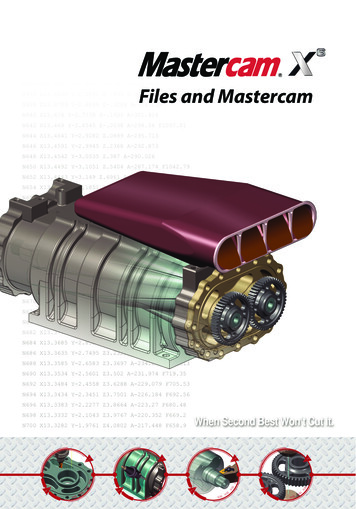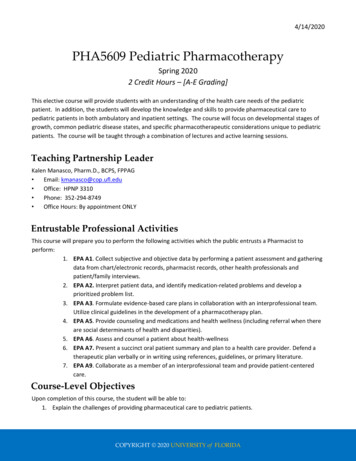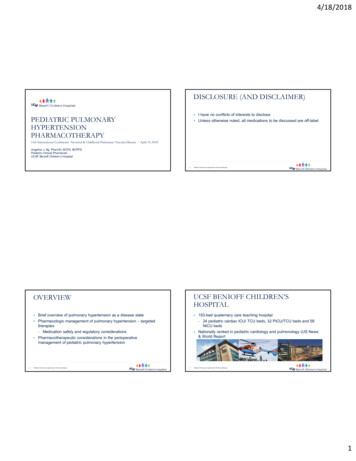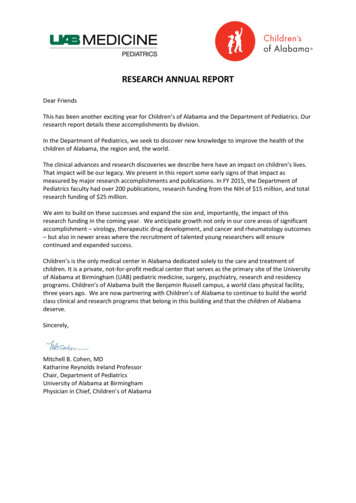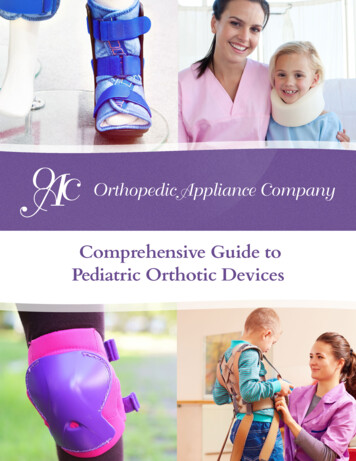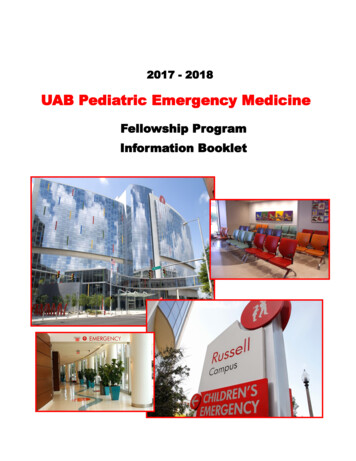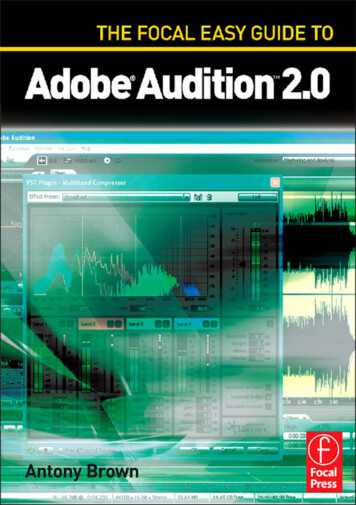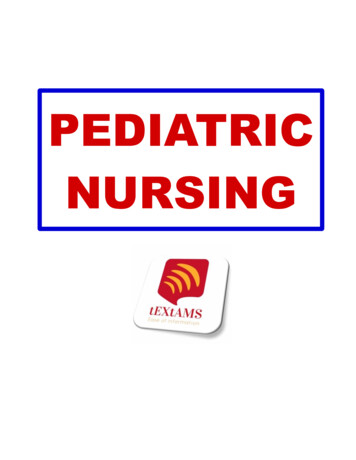
Transcription
PEDIATRICNURSING
GROWTH AND DEVELOPMENTGrowth Increase in physical size– Weight Birth weight: Pounds and ounces Medications and fluid: metric system– Height or length– Head circumference Measured routinely birth to age 2 yearsHeight: (length measure lying down until age 2 years).IMPORTANT CONVERSION FACTS:1 kilogram 2.2 pounds16 ounces 1 pound (lb)2.25 (2.2) centimeters 1 inch1 kilogram of weight equals approximately 1 literAftergrowth 2017 Feuer Nursing Review LLC. All Rights Reserved. Unauthorized copy or distribution is strictly prohibited.[1]
Development Increase in function Sequence is specific, not rate– Rate is uneven and individual withgreatest speed during infancy andpuberty Cephalocaudal– Head to Toe (tail) Proximal to distal– Center to the peripheryDevelopmental Milestones A standard of reference or growth marker Denver Developmental Testing– Used for infants to 6 year children– Requires 30 minutes to complete– May evaluate Gross motor skillsFine motor skills-AdaptiveLanguagePersonal - Social skillsGross motor skill examples: sits with head steady, rolls over, walks up steps, hopsFine motor skill examples: grasps rattle, pincer grasp, builds tower of cubesLanguage skill examples: responds to bell, points to picture, name one colorPersonal-social skill examples: smiles spontaneously, waves bye-bye, brushes teeth with helpLogotypes 2017 Feuer Nursing Review LLC. All Rights Reserved. Unauthorized copy or distribution is strictly prohibited.[2]
Infant Physical Growth Weight– Doubles in six months birth weight: 6 lbs 10 oz Six months: 13 lbs 4 oz ( 12lbs 20 oz)– Triples in one year One year: 19 lbs 14 oz Height– Increased by 50% in one year 20 inches at birth plus 10 (50% 0f 20) 30 inchesat one yearInfant growth Head circumference Fontanelsmeasured to age 2– Posterior closure at 3monthsyears– Anterior closure at 12 to18 monthsTooth eruption begins 4-6 months (then 1 tooth per month)Tattooers 2017 Feuer Nursing Review LLC. All Rights Reserved. Unauthorized copy or distribution is strictly prohibited.[3]
Percentiles Measure for age How to chart . What is “normal”– 5%-95%– What is not Respiratory rate is most variable with sleep and wake cyclesMeasure RR and rhythm firstInfant normal: 30-60 breathes/minutePeriodic breathing is a normal for the newborn (birth to 28 days) with pauses in respirationof 3-5 seconds and short bursts of tachypnea.Apnea is abnormal cessation of breathing for greater than 15–20 seconds typicallyaccompanied by bradycardia, hypotonia (floppiness) and cyanosis. (The first intervention istactile stimulation)i-goT 2017 Feuer Nursing Review LLC. All Rights Reserved. Unauthorized copy or distribution is strictly prohibited.[4]
PSYCHOSOCIAL/LANGUAGEFINE AND GROSSMOTORPLAY/TOYS AND SLEEP3 MonthsPsychosocial– Social smile– Know primary caregiver Motor (reflexes)– Lift head and chest in proneposition– Moro / grasp and tonic neckreflexes are fadingToysmobilemirrorFollows objects witheyes(best vision 12-15inches)Lifts head and chest inprone positionSolitary PlayMusic boxMobileMirrorRolls side to backNeonatal reflexes beginto fadeSafety is of primary concern(No smaller than child’s fist, cords nolonger than 14 inches, no sharp edges)Sleep: 10–16 hours in about 5 sleepperiods 2017 Feuer Nursing Review LLC. All Rights Reserved. Unauthorized copy or distribution is strictly prohibited.[5]
PSYCHOSOCIAL/LANGUAGEFINE AND GROSSMOTORPLAY/TOYS AND SLEEPSix Months Old Psychosocial– Apprehension of strangers– Babbles and coos Motor– Rolls well– No head lag– Sits with help– Hand to hand transfer Toys– Rattles (Palmer grasp)– Soft toysObservesenvironmentInitiates play bysmilingRecognizes ownnameRolls from side to sideNeonatal reflexes fadedMoro or startleGraspRootingFencing(asymmetrictonic neck)Soft toysBright colorsRattleSleep: 14 hours of sleep with longer periodat night and 2-3 napsUses palmer grasp 2017 Feuer Nursing Review LLC. All Rights Reserved. Unauthorized copy or distribution is strictly prohibited.[6]
PSYCHOSOCIAL/LANGUAGEFINE AND GROSSMOTORPLAY/TOYS AND SLEEPNine Months Old Psychosocial– Waves bye bye– Stranger anxiety– ObjectpermanenceCries when scoldedTwo syllableswithout meaning(mama, dada)Repetitive speechsoundsMotorSits wellPincer graspPulls to standSits well withoutassistanceTransfers objects fromhand to handPeek a booCause and effectCloth booksSleep: 12-14 hours with longer period atnight and 1-2 naps per day 2017 Feuer Nursing Review LLC. All Rights Reserved. Unauthorized copy or distribution is strictly prohibited.[7]
PSYCHOSOCIAL/LANGUAGEFINE AND GROSSMOTORPLAY/TOYS AND SLEEPTwelve Month Old Psychosocial– Imitates– Mama and Dada has meaning– Two words Motor– Turns pages– Walks with assistance– Stands without assistance Toys– Push toys– Nesting toysCooperates withdressingShows jealousyRecognizes themeaning of NO!Claps handsPush toysLarge ballNesting toysLarge blocksSleep: 12- 14 hours with longer period atnight and 1-2 naps per dayManaging the stress of hospitalization Encourage rooming in Place near the nursing station Consistent nursing staff / Primary Nursing Hold for feedings Sucking / pacifier use 2017 Feuer Nursing Review LLC. All Rights Reserved. Unauthorized copy or distribution is strictly prohibited.[8]
ImmunityPassive immunity– Placental transfer and via breast feeding– Immunoglobin administration (IGG)Active Immunity is acquired throughdisease exposurevaccine administrationVaccines may beLive attenuated (weakened): MMR, OPV, Varicella,flumistInactivated (killed): IPV Injectable flu, pertussisToxoid (toxins): Diphtheria, tetanusComponent: HIB, HepB, HepA, PCVHealth Maintenance: Immunization ScheduleFederal law requires giving a Vaccine Information Statement (VIS) to the parents of thechild prior to the administration of the vaccine. The VIS is available in many languages andcontains information on the purpose, effects, common and uncommon side effects.Hepatitis B 3 injections beginning at birth, 1-2 months and 6-18 months (IM) If mother isHep B positive, the newborn also receives hep B immunoglobinSE: soreness at the site, feverContraindication/Precaution: yeast allergyDisease: prevents infection and the risk of chronic infection and subsequent liver cancerNsg Care: Interferon Alfa, condom use for chronic carriersRotovirus oral vaccine given at 2, 4 and 6 monthsSE: diarrhea, intussusception (1:100,000)Contraindications /Precautions: History of intussusception or immunosuppressionDisease: most common cause of severe diarrhea in childrenNsg Care: Rehydration, contact isolation, instruct family on good hand hygiene 2017 Feuer Nursing Review LLC. All Rights Reserved. Unauthorized copy or distribution is strictly prohibited.[9]
DTaPDiphtheria, tetanus, pertussis (whooping cough) 5 doses@ 2 months, 4 months, 6 months, 15months, and 5 years (IM)SE:Fever (up to about 1 child in 4)Redness, swelling or soreness where the shot was given (up to about 1 child in 4). Theseproblems occur more often after the 4th and 5th doses of the DTaP series than after earlierdoses.Other mild problems include: fussiness (up to about 1 child in 3), tiredness or poor appetite(up to about 1 child in 10), vomiting (up to about 1 child in 50).Contraindications / Precautions: Neurological complications after previous administration ofDTaP including seizures fever 105 or greater, or inconsolable cryingDisease: Diptheria (Corynebacterium diptheriae) manifests with a gray mucous membranedeveloping over the tonsils and lymphadenopathyNsg care: contact isolation, IV antitoxin, Antibiotics, rest fluids, acetaminophenDisease: Tetanus (Clostridium tetani). Infection generally occurs through woundcontamination, and often involves a cut or deep puncture wound. As the infection progresses,a neurotoxin is released resulting in muscle spasms in the jaw (lockjaw). This is followed bydifficulty swallowing and general muscle stiffness and spasms. (not contagious)Nsg care: immunoglobin, PCN, valium, quiet calm environmentDisease: Pertussis (Bordetella pertussis) also known as Whooping cough, spread by droplet ordirect contactNsg Care: respiratory precautions, infants are typically hospitalized, erythromycinHIB Four doses given at 2 months, 4 months, 6 months, and 12-15 months of age. (IM)SE: redness pain at the injection siteContraindications / Precautions: less then 6 weeks of ageDisease: Haemophilus influenzae B infections can cause a severe and potentially fatal illness,pneumonia, meningitis, epiglottitis and sepsis.Nsg Care: respiratory isolationsPCV: Inactive vaccine; four doses given at 2 months, 4 months, 6 months, and 12-15 monthsof age. (IM)SE: drowsiness, loss of appetite, redness at site, fever, fussyContraindication / Precautions: allergy to PCV or diphtheria vaccineDisease: Pneumococcal bacterial infection may cause pneumonia or sepsis 2017 Feuer Nursing Review LLC. All Rights Reserved. Unauthorized copy or distribution is strictly prohibited.[10]
Polio Four doses given at 2 months, 4 months, 12-15 months and 5 years(IM)OPV: Oral polio vaccine: live attenuated vaccine developed by Dr. Sabin, inexpensive, easy toadminister, highly effective, NOT used in US at presentSE: paralysis in the vaccinated child or a close contact (1 in 2.4 million)Contraindications / Precautions: Immunosuppression in child or care giver, pregnancyIPV: Inactivated polio vaccine,SE: injection site sorenessContraindications / Precautions: allergy to neomycin or streptomycinDisease: polio is a viral illness spread from person-to-person, primarily via the fecal–oralroute. Many polio infections are asymptomatic; if the virus enters the CNS paralysis canoccur.Influenza: recommended annually for all children after 6 months of ageInjectable (inactive) (IM) first vaccination 2 doses 4 weeks apartSE: soreness redness at injection siteContraindication / Precautions: egg allergy, hx of Guillain-Barre SyndromeIntranasal (Flumist) LAIVSE: runny nose, headache, muscle ache, fever, wheezing, abdominal painContraindications / Precautions: history of wheezing, pregnancy, immunosuppression, aspirintherapyMMR: 2 doses given at 12-15 months and at 5 years of age. (SQ)Use vaccine immediatelyafter reconstitution. May be given same day as varicella (other live vaccine) or 30 days apart.MMR administration should NOT be done at the same time as TB test (increased risk of falsenegative reaction)SE: Fever, rash, seizure, joint pain, low plt countContraindications / Precautions: Pregnancy, Immunosuppression, Recent blood producttransfusion (11months), history of ITPDisease: Measles: (rubeola) Viral infection presenting with rash, high fever, cough, runny nose,and red, watery eyes (lasts about a week). Complications of measles are common and include:diarrhea, ear infections, pneumonia, encephalitis, seizures.Nsg Care: infant may be hospitalized, greater risk of complications, vitamin A, dim lights, cleaneyelids with saline, respiratory isolationDisease: Mumps: Viral infection presenting with fever, headache, and muscle aches, tiredness,and loss of appetite; followed by swelling of salivary glands. The parotid salivary glands aremost frequently affected. Male sterility is a complication.Nsg Care: Fluids, warm or cool compresses on glandsDisease: Rubella Also called German Measles. A viral illness that presents with rash and feverfor two to three days (mild disease in children and young adults). Birth defects if acquired by apregnant woman: deafness, cataracts, heart defects, mental retardation, and liver and spleendamage (at least a 20% chance of damage to the fetus if a woman is infected early inpregnancy) 2017 Feuer Nursing Review LLC. All Rights Reserved. Unauthorized copy or distribution is strictly prohibited.[11]
Varicella: Live attenuated vaccine, 2 doses given at 12 -15 months and 5 years. (SQ)SE: pox and feverContraindications / Precautions: immunosuppression, pregnancy, recent blood productadministration, antiviral medicationDisease: Varicella (chickenpox) is an acute, highly contagious viral disease with worldwidedistribution. While mostly a mild disorder in childhood, varicella tends to be more severe inadults. It may be fatal, especially in neonates and in immunocompromised persons.May cause disseminated disease affecting the lungs and brain.Nsg Care: Respiratory isolation, calamine lotion, cool bath with baking soda or oatmeal, shortclean nails, acetaminophen (no ASA)Hepatitis A 2 doses given 6 months apart starting at one year of age (IM)SE: soreness, tiredness, headacheContraindications /Precautions: PregnancyDisease: flu like ilness, jaundice and stomach painMeningococcal: subcutaneous injection, at 11-12 years, those living in dorm-like conditionsand those with anatomic or functional asplenia (Sickle cell anemia)SE: redness and soreness at the site, Guillain-Barre SyndromeContraindication / Precautions: Guillain-Barre SyndromeDisease: Meningococcal meningitis (Neisseria meningitidis) meningitis often with petechial orpurpura rash.Nsg Care: Respiratory isolationHPV: recommended for males and females between the ages of 9-18, 3 doses series 2017 Feuer Nursing Review LLC. All Rights Reserved. Unauthorized copy or distribution is strictly prohibited.[12]
NUTRITION IN INFANCYNutritionBM / Formula– Fluoride– Iron– Vitamin DSolids– 4 months– Saliva, sitting, tongue– Begin with riceNew foods every 4 -7days– Skin rash / diarrheaAllergy– Strawberries, egg whites,peanuts, tree nuts, shellfish,fishTable food at 9 monthsNo honey or corn syrupInstructions for FeedingBreast milk or iron fortified formula for firstyearDo NOT heat in microwaveFood IntroductionSupplements may include: Vitamin D(especially in babies born in the winter)Do NOT prop bottles (must be caregiver orinfant held)Fluoride begun at age 2 weeks (continued toage 12 years) for children with nonfluoridated water.Breast milk may be refrigerated for 48 hoursand frozen for up to 6 monthsFruits/vegetables: 6 months (nostrawberries)Meats/eggs: 9 months (no egg whites, nofish, no shellfish, no peanuts)Weaning is the transition from bottle or breast feeding to a cup, typically begun at 8 monthsof age. Weaning should be done gradually, one feeding at a time, with the nighttime feedinglast. 2017 Feuer Nursing Review LLC. All Rights Reserved. Unauthorized copy or distribution is strictly prohibited.[13]
Anticipatory GuidanceAnticipatory Guidance is the process of understanding upcoming developmental needs andthen teaching caregivers to meet those needs.Anticipatory Guidance for Infants Falls especially whenlearning roll andlearning to walk– NO walkers! Car seats– Rear facing to one year and 20 pounds or as long as indicted bythe car seat Sun protection– Sunscreen after 6 months of age “BACK TO SLEEP” Illness recognition: rectal temp 100.4, cough, failure toeat, 8 wet diapers / dayAdditional Sample Topics of Anticipatory Guidance in Infancy1. Anemia and lead check at 9 months2. Sleep: normal patterns and positions. Place infant to sleep on back, when they can rollover there is no need to reposition. Crib slats 6 cm (2 3/8 inch) apart3. Car safety: middle back seat is the safest location, the least safe is the front seat withor without an airbag4. Burn prevention: physical protection, hat, clothing shade to 6 months, thensunscreen. Water heater temperature 120 degrees 2017 Feuer Nursing Review LLC. All Rights Reserved. Unauthorized copy or distribution is strictly prohibited.[14]
ToddlerAge 1-3 years Autonomy versus shameand doubt Developing independence Tolerating frustrationErikson: Autonomy vs. Shame and Doubt - The child develops a sense of independencethrough exploration of the world around him and encouragement from the primary caregiver.The child learns to tolerate frustration through socialization and toilet training. Failure toachieve autonomy may leave the child feeling doubtful about his abilities.Physiologic growth during the Toddler Birth weight quadruples by 3 years Anterior fontanel closes at 18 month Potbelly appearance Bowed legs 2017 Feuer Nursing Review LLC. All Rights Reserved. Unauthorized copy or distribution is strictly prohibited.[15]
PSYCHOSOCIAL/LANGUAGEGROSS AND FINE MOTORPLAY AND TOYS18 Month Milestones Psychosocial– Up to 25 words and2-3 word phrases– “MY”– Separation Anxiety Motor– Walks independently by 15months– Uses Tools Toys– Push and pull toys– Blocks– Cause and effect Spoons, shovels– Climbs– 3-4 block towerFollows simple directionsPoints to body partSeparation anxietyDrinks from a cup (spillsoften)Toothbrush without pasteScribbles with crayonCause and effect 2017 Feuer Nursing Review LLC. All Rights Reserved. Unauthorized copy or distribution is strictly prohibited.[16]
24 month Milestones Psychosocial– Negativistic behavior– Transitional object– Temper tantrums Motor– Up and down stairs– Removes clothes Play– Parallel play– Manipulation of environment3-4 word sentencesBowel controlParallel Play300-400 word vocabularyKicks ballRiding toysNames picturesJump in placeFinger paintsTurns door knobsWater playTower of six blocksSandScreen activity (TV/computer) 2 hours per dayManaging temper tantrums inToddlerhoodPrevent with routine and limitedacceptable choicesPromote extinction through:Monitor for safetyIgnore behaviorDo NOT reason with, threaten,promise, give in! 2017 Feuer Nursing Review LLC. All Rights Reserved. Unauthorized copy or distribution is strictly prohibited.[17]
Nutrition in the Toddler Years Physiologic Anorexia– Small frequent snacks / meals (6 per day) Food jags / Picky Eater– Offer nutritious foods Whole milk– Begin at age one year– May switch to low fat at age 2 years– No more than 24 oz per day Iron rich foods (infant cereal) Five- a-day– Fruits and vegetables Choking hazards– All foods cut into small pieces for young toddlersToilet Training Readiness––––Able to hold urine for 2 -4 hoursAge 2 yrsDiscomfort at messy pantsSensation before excretion Parental involvement– Specific words time and place Pleasant mood– Teach hand washing and front to back wiping– No punishment / immediate reinforcement ofpositive behavior 2017 Feuer Nursing Review LLC. All Rights Reserved. Unauthorized copy or distribution is strictly prohibited.[18]
ISSUES RELATED TO HOSPITALIZATIONIssuesNursing InterventionSeparationa. Caregiver rooming inb. Primary nursingc. Offer transitional objectLoss of Controla.b.c.d.e.f.Regressive BehaviorOffer appropriate choicesSet limitsMaintain ritualsUse treatment room for invasive/painful proceduresPreparation should include description of sensation and howthey can cooperatePreparation should be concise and immediately prior toprocedurea. Anticipatory guidanceb. ReassuranceAnticipatory Guidance for Toddlers Discipline– “Time outs” placing child in a safe non-stimulating area One minute for each year of age– Ignoring tantrums (extinction) Not a discipline issue in toddler years Water Safety– Never unattended near tubs, toilets, pools or buckets Electrical safety Choking– Toys, bean bags, foods Car seats– Until 4 years legally Accidental ingestions– Locks and latches on cabinets– Keep products in original containers 2017 Feuer Nursing Review LLC. All Rights Reserved. Unauthorized copy or distribution is strictly prohibited.[19]
Preschools Years Age 3 – 6 years old Initiative versus Guilt Physiologic Growth– Weight gain 3-5 lbs/yr– Vision 20/40 (E test)– 20 deciduous teeth– Handedness established– Day time toilet training completeErikson: Initiative vs. Guilt - the child develops a sense of self esteem through task, questionsand play. Conflict will arise when the child oversteps the limits of his/her abilities and willacquire a sense of guilt for not behaving appropriately. 2017 Feuer Nursing Review LLC. All Rights Reserved. Unauthorized copy or distribution is strictly prohibited.[20]
PSYCHOSOCIAL/LANGUAGEFINE AND GROSS MOTORPLAY AND TOYS3 Year Milestones Psychosocial–––––– MotorTalkativeAgreeableNightmares / night terrorsKnows first and last nameKnows gender differencesMasturbation– Runs well– Peddles tricycle– Walks on tip toe– Alternates feetgoing up and down– 9- 10 block tower Normal, managed withdiversion11,000 words, 4-5 wordsentencesKnows 2 colorsEgocentric, boasting,Nightmares / night terrorsImitate adult behaviorsMasturbationDresses and undressesHolds a pencil with a tripodgraspTricycleColoringPuzzlesNursery Rhymes / Songs 2017 Feuer Nursing Review LLC. All Rights Reserved. Unauthorized copy or distribution is strictly prohibited.[21]
PSYCHOSOCIAL/LANGUAGEFINE AND GROSS MOTORPLAY AND TOYS4 and 5 year olds Psychosocial– Magical thinking / fear of monsters– Stuttering (dysfluency)– Fear of body mutilation– Inquisitive Motor– Alternate feet on stairs– Uses scissors– Catches ballShares well, begins to havedesire to please othersKnows first and last nameInquisitive questions (the “W”questions”)Copies a triangle/draws apersonToothbrush with paste (canspit)Associative playColoring booksArts and craftsDramatic playPuppetsStory time 2017 Feuer Nursing Review LLC. All Rights Reserved. Unauthorized copy or distribution is strictly prohibited.[22]
Preschool Play Associative and Dramaticplay– Loosely organized groups– Rules change Toys– Tricycle– Dress up– Dolls– Coloring books Separation––––PreschoolerRooming inFamily picturesPhone callsLeaving a parent’s belonging behind Bodily mutilation– Fear of intrusive procedures– Concrete / neutral language– Band-AidsIt will just be alittle stick! Loss of control– Offer choices– Set limits 2017 Feuer Nursing Review LLC. All Rights Reserved. Unauthorized copy or distribution is strictly prohibited.[23]
Anticipatory Guidance for Preschoolers Street and Pedestrian Safety– Bikes travel with traffic (on the right)– Pedestrians travel against traffic (on the left) Safety around animals– Never approach animals you do not know– Never approach a wild animal (non-pet) Teach full name, address, telephone number and 911 Car seats– Until 4 years legally– Boosters Typically used to 60 lbs Lap belts without boostersincreases the risk of spinal injuryReadiness for KindergartenPicks up after himselfAble to be without parents forshort periods of timeFollows directionsSpeaks in complete sentences 2017 Feuer Nursing Review LLC. All Rights Reserved. Unauthorized copy or distribution is strictly prohibited.[24]
School Age Development Age 6- 12 years Industry versus Inferiority Physical Growth– Permanent teeth(pre-op check for loose teeth)– Weight double between age 6 and 12boys and girls close in size– Age 6 years: 20/20 vision (Snellen chart)– Enuresis and sleepwalking are common issuesErikson: Industry vs. Inferiority - the child achieves a sense of personal and interpersonalcompetence by acquisition of technologic and social skills. Inability to acquire a sense ofaccomplishment and lack of encouragement will result in a sense of inferiority.School Age Development Psychosocial– Same gender friends “BFF”– Collections– Enjoys school Competition andcooperation Develops morals Motor– Refinement ofcoordination andbalance– Two wheeler– Cursive writing 2017 Feuer Nursing Review LLC. All Rights Reserved. Unauthorized copy or distribution is strictly prohibited.[25]
PSYCHOSOCIALMOTORACTIVITIESLoves school/seeks praisePhysical skills maximizedCooperative / Group playCollects thingsRoller-skates / Ice-skatesBoard gamesInteractive and group playCard gamesDevelops modestyVideo gamesDaydreamingOrganized competitionPhobiasPlaying musical instrumentsCollections (i.e. baseball cards)Issues of Hospitalization forthe School Aged Child Separation from family and school– Tolerates separation but prefers parents close by– Letter from schoolmates / peers– Telephone calls– Maintain school work Fear of bodily injury / mutilation– Explain all procedures– Fear of pain Need for privacySample Topics of Anticipatory Guidance for School-age Children1. Home fire drills2. Bicycle safetya. Helmets and ride on the right side of the road3. Interactions with strangers 2017 Feuer Nursing Review LLC. All Rights Reserved. Unauthorized copy or distribution is strictly prohibited.[26]
Adolescence Age 13 – 18 years Identity versus Role Confusion Physiological– Rapid growth rate 3-4 inches per year– Puberty (Tanner Scale 1-5) Female begin 10 -14 years Order of girls’ secondary development: height spurt, breastdevelopment, pubic hair, menarche Menarche 12 - 13 years(hgt 95% of adult at onset) Male onset 12- 16 years (95% of adult hgt at age 15) Order of boys’ secondary development: testes enlarge, pubic hair,penis increases, height spurt, voice change, facial hairErikson: Identity vs. Role Confusion. The adolescent focuses on independence from the familyand uses the peer group as a bridge between dependence on the family and completeindependent behavior.Adolescence Psychosocial– Rebellious behavior (challenging authority)– Peer pressure (risk taking)– Body image Play / Activities– Clique formation– Team sports– Intimate relationships Hospitalization– Separation , Body image (privacy and clothes) andNon compliance 2017 Feuer Nursing Review LLC. All Rights Reserved. Unauthorized copy or distribution is strictly prohibited.[27]
Adolescent Anticipatory Guidance Nutrition– Iron and calcium MVC (motor vehicle crash) Personal safety issues– Sexual activity– Suicide– Smoking, Drug and Alcohol AbusePSYCHOSOCIALMOTORDeductive reasoningIntense relationshipsMaximized strengthMaximized fine motor skillsACTIVITIESGroup activitiesClubsVideo gamesOrganized competitionSports teamsIntimate relationshipsISSUES RELATED TO HOSPITALIZATIONIssuesNursing InterventionSeparation from friendsa. Encourage friends to visitb. Telephone privilegesBody image disturbancea. Provide privacyb. Assist with ADLsc. Allow to wear own clothesNon compliancea. Encourage use of support groupb. Reward compliant behavior 2017 Feuer Nursing Review LLC. All Rights Reserved. Unauthorized copy or distribution is strictly prohibited.[28]
OTHER DEVELOPMENTAL THEORIESAgePiagetFreudKohlbergCognitive developmentPsychosexualdevelopmentMoral developmentSensorimotor: the babylearns from sensory andmotor inputOral stage: the bayobtains pleasure andcomfort through themouthPreconventional Stage 0:ToddlerPreoperational /Preconceptual: symbolsstand for objectsAnal stage: the toddlerobtains gratification fromcontrolling bodilyexcretionsPreconventional Stage 1(2-3 yrs): demonstratesacceptable behavior toavoid punishmentPreschoolPreoperational /Preconceptual: symbolsstand for objectsGenital / Phallic:identification with samesex parentConventionalStage 2 (4-7 yrs):Conforms to rules toplease othersPreoperational / Intuitive:thinking and learning isconcreteLatency: importance onprivacyConventionalSchool ageBirth to18monthsNo awareness of right orwrongStage 3 (7-10 yrs): beinggood is important andmeans showing concernfor othersConventionalStage 4 (10-12 yrs):increased concern withsociety as a wholeAdolescenceConcrete operational:rational thought whenallowed to manipulate andsee objectsGenital: focus on genital;function and relationshipsPost-Conventional(Stages 5 & 6)Focuses onindividual rights andprinciples of conscience.Act on self chosen ethicalprinciples (age 13 years) 2017 Feuer Nursing Review LLC. All Rights Reserved. Unauthorized copy or distribution is strictly prohibited.[29]
PROVIDING NURSING CARE TO CHILDRENMedications and Intravenous TherapyGeneral Considerations:1. All pediatric doses are calculated according to the child's weight or body surface area.2.3.4.5.6.7.Allow the child to make appropriate choices to gain cooperation.Never force a child to take a medication.Never tell a child a medicine is "candy".Do not mix with a favorite food or formula.Ask parents about successful methods.When administering otic medication in children less than 3 years old the pinna should bepulled down and back.PEDIATRIC MEDICATION EXAMPLESTylenol 10 mg/ kg / dose (15 kgs)150 mg PO Q4 hours PRN temperature 38.5 CelsiusAmpicillin 100 mg/kg/day (15 kgs) IV divided Q 8hrs500 mg IV Q 8 hours 2017 Feuer Nursing Review LLC. All Rights Reserved. Unauthorized copy or distribution is strictly prohibited.[30]
ORALINTRAMUSCULARUse dropper, syringe or small cupSuspensions must be shakenUse TB syringe for amounts 1 mlUse vastus lateralis inchildren who have not beenwalking for one full yearPlace in buccal mucosaNo more than 0.5mL in theinfant and 1mL in the childin each siteReclining but not flat (never pinchthe nose)Ventrogluteal secondary sitefor infants and toddlersMix with small amount of flavoring( one ounce)Dorsogluteal notrecommended for childrenunder 3 yearsIf child vomits consider toxicitybefore redosing.Do not crush enteric coated ortime released medicationDeltoid is used for smallvolumes of non-viscoussolutionsINTRAVENOUSOnly use microdrip (60 gtt/mL)Assess site Q 1 HourInfiltration ManifestationsPale, cool, swollen, painfulInfiltration ManagementStop infusion, Removecatheter, Elevate extremity,consider reversal medicationPhlebitis ManifestationsRedness, warmth, pain, slightswellingPhlebitis ManagementStop infusion, removecatheter, warm compressNEEDLE CHOICE FOR IMAgeInfantToddler and olderGaugeLength(inches)23 - 250.5 – 1221 – 1.5Hospital Safety Protocols:1. All children less than 3 years old must be in a crib with a dome covered top.2. Side rails must be all the way up when the child is in the crib.3. Children under 6 years may not be left unattended unless they are in their cribs.4. Do not prop bottles.5. Place infants on their backs to sleep.6. Safety belts are not restraints. 2017 Feuer Nursing Review LLC. All Rights Reserved. Unauthorized copy or distribution is strictly prohibited.[31]
PREPARING AND MONITORING CHILDREN FOR PROCEDURESPreparationRestraintGive simple truthfulexplanations.Use the least amount ofrestraint to achieve safety.U
2017 Feuer Nursing Review LLC. All Rights Reserved. Unauthorized copy or distribution i


